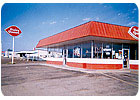
The owner of this Dairy Queen might have had a lot more to worry about than dripping ice cream cones, had one its refrigeration technicians not de-cided to use a refrigeration sealant to repair its ice cream machine and walk-in cooler.
After discovering a new HVAC and refrigeration sealant last year, 18-year-veteran service tech Mark Upshaw is now convinced that a lot of food service and HVAC equipment has prematurely landed in the junkyard.
Upshaw estimated he single-handedly revitalized more than $40,000 worth of refrigerant-leaking food service and HVAC equipment over the last year as a maintenance technician for Gila Enterprises in Alpine, TX, a small real estate investment/management company with about 10 properties. Upshaw, who started with Gila in 1988 after running his own HVACR service company in Arizona, estimates he could have saved the company an additional $100,000 in equipment if refrigerant sealants were available throughout the 1990s.
SOFT-SERVE SAVIOR
The greatest success story to date is a soft-serve ice cream machine at a 26-year-old Dairy Queen in Marfa, TX, that Gila operates as a franchisee. Upshaw's electronic leak detecting didn't surface a visible leak, but it did assure him that a leak was inaccessible and most likely located in the water cooled condenser. Since the 15-year-old, one-ton unit was leaking and would also eventually need a refrigerant retrofit from R-12 to an environmentally-friendly HFC refrigerant, the manufacturer recommended replacing the $30,000 unit.Instead, Upshaw recovered the remaining R-12 refrigerant, changed the Schraeder valves and caps, and added a 3-oz can of Super Seal HVACR™ by Cliplight Mfg. of Toronto, while retrofitting the system with Hot Shot R-414b refrigerant by Icor International of Indianapolis. The sealant is specially formulated for HVACR systems under five tons and is vastly different from automotive refrigeration sealants.
The service call and the $60 can of sealant amounted to $300, which is about 1% of the replacement cost the operation faced. "Gila Enterprises was very pleased because they knew what a new soft serve machine would cost," said Upshaw.
The equipment manufacturer warned Upshaw that a sealant could clog small capillary lines in the unit, but Upshaw found that information to be false since it has been running over one year and performing up to original specifications without incident. "If the system is properly prepared prior to injection, the sealant is engineered to seal micron leaks with zero negative effects to compressors, expansion valves, or any other system components," said Paul Appler, director of research, Cliplight Mfg. "Moisture is public enemy number one to refrigeration units. Regardless of size, every unit should have a fully functional liquid line drier installed. Good workmanship mandates changing the drier out. When refrigerant is removed, always follow up with a triple evacuation using nitrogen breaks to completely eliminate moisture from a system."
Upshaw was confident the sealant would work because it was strongly recommended by other service techs and counter salesmen at a local HVACR distributor, Johnson Supply of Carrollton, TX. Plus, a few months earlier he also used it successfully on a split-system A/C system at a Gila-owned residential rental property.
KEEPING THE WALK-INS UPRIGHT
More recently, the Dairy Queen's walk-in freezer and walk-in cooler were both faced with component replacement costs that could have surpassed an estimated $10,000, but Upshaw again used a sealant to lower repair costs.With the 120-sq-ft freezer, an electronic leak detection test turned up no visible leaks and Upshaw suspected it was either hidden in a fancoil, the in-wall piping, or the condenser. Instead of troubleshooting by replacing expensive fancoils, Upshaw put in the sealant while retrofitting the R-12 unit to R-414b. The freezer is working fine today at its 12ºF temperature original equipment specification.
The emergence of Super Seal HVACR for systems between 1-1/2 and five tons and its companion product for systems five tons and over, Super Seal 3 Phase, are now part of the Gila Enterprises refrigeration servicing strategy. Equipment is leak checked then repaired conventionally, if possible. If the leak is inaccessible or undetectable, the sealant is used as a last resort to save the equipment from replacement. "If I had this sealant years ago, I could have helped a lot of people save their equipment from the junkyard," said Upshaw.
